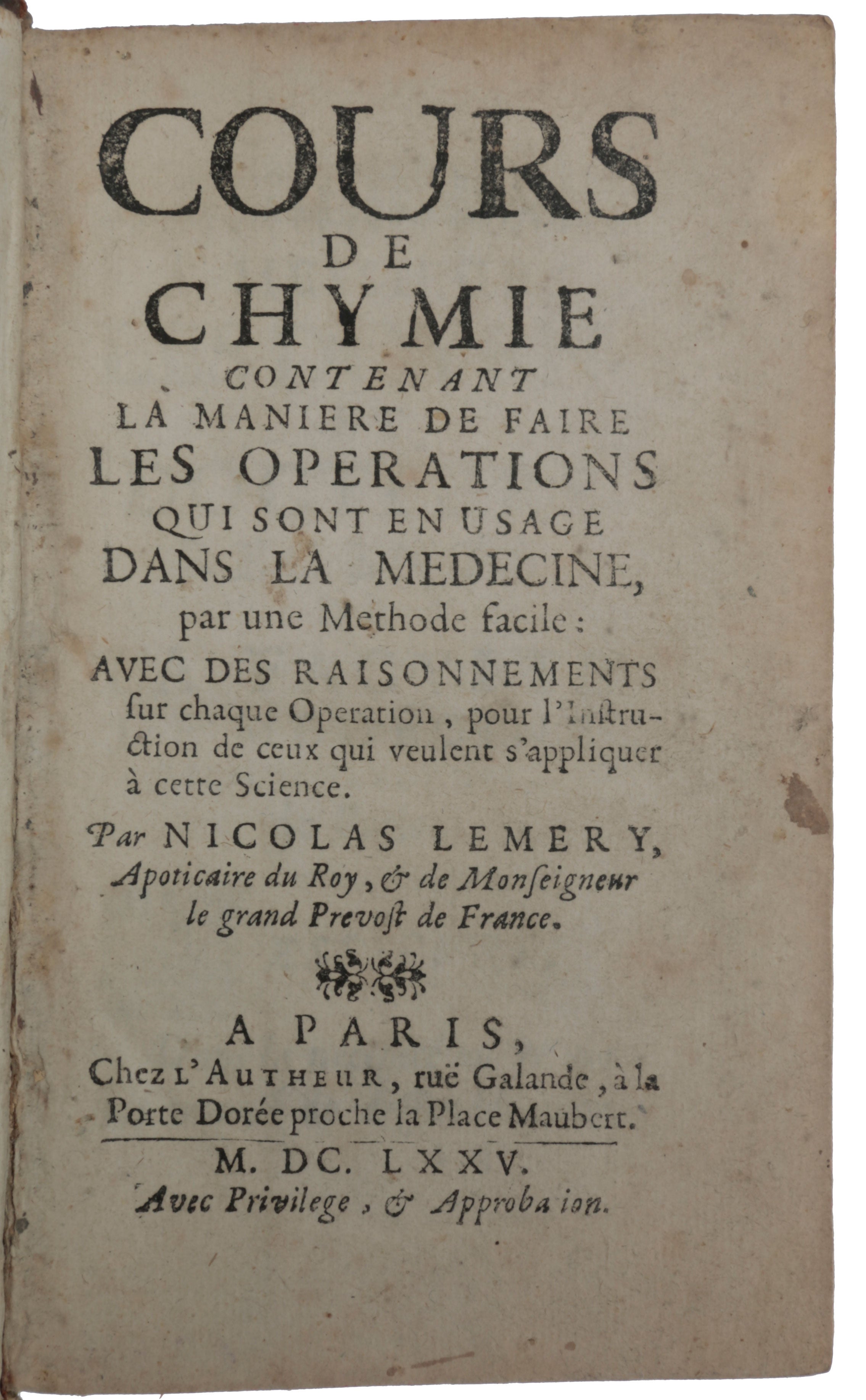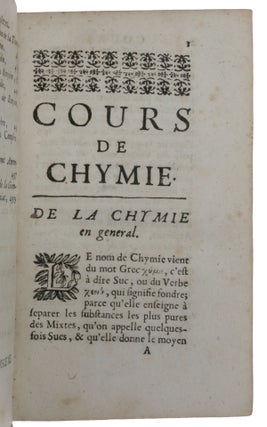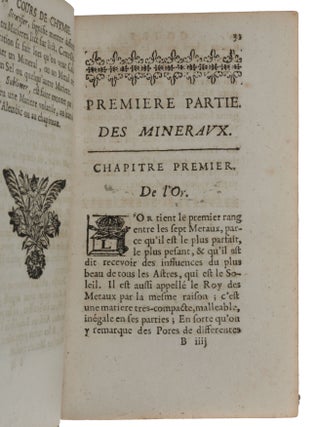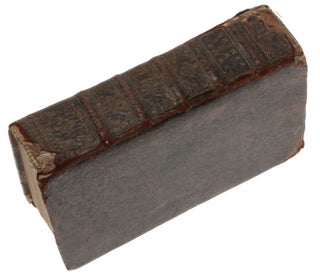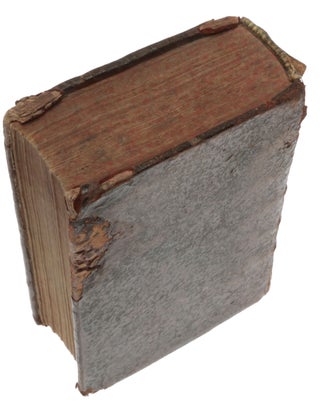Cours de chymie contenant la manière de faire les operations qui sont en usage dans la médecine, par une méthode facile.
Paris: chez l’Auteur, 1675. First edition, very rare, of the author’s famous chemical textbook. “Lemery’s highly successful Cours de chymie, which served as the textbook to his popular courses on chemistry, brought French chemical teaching out of the quasi-mystical Paracelsian tradition into the mainstream of Cartesian and atomistic natural philosophy. The significance of this work lies not in its originality or its thoroughness – Lemery followed very closely the works of his predecessors Le Febvre and Glaser, and did not develop any rigorous theories of matter – but rather in its attractive presentation of chemical ideas in corpuscular-mechanist terms, which contributed to the book’s overwhelming popularity. Cours de chymie sold ‘like a work of romance or satire’ (Fontenelle, quoted in Partington); it went through numerous editions and was translated into Latin and all the major European languages” (Norman). “One of the most influential chemists of his time, Lemery (1645-1715) condemned the obscure alchemical mysticism of contemporary authors. He gave lectures on the principles of chemistry in a clear and simple way, including experimental demonstrations, from his manufacturing laboratory in Paris. The lectures were attended by crowds of people from Paris, other parts of France, and abroad. The Cours de chymie, the textbook of his course of lectures, enjoyed unprecedented success for a work of its kind. Although based on the Traité de la chymie (Paris, 1663) of Christophle Glaser and the Pratique de chymie (Montpellier, 1671) of Sebastien Matte le Faveur, both of whom were former teachers of Lemery, he nowhere acknowledges their works. The first and earlier editions of the Cours were sold by Lemery from his house in Paris and are now very rare. He was careful to revise, correct, and update at least eleven editions himself, the last appearing in 1716. Posthumous editions were published until 1756, each keeping current with new material” (Neville Historical Chemical Library II, p. 39). ABPC/RBH list only two copies. The Haskell F. Norman copy (bought from Quaritch in 1988), is now in the Neville Historical Chemical Library. Provenance: ownership inscription to lower endpaper. “In the summer of 1670 [Lemery] was registered as a student of pharmacy in Montpellier and was permitted to attend the courses on ‘simples’ and anatomy given at the Faculty of Medicine for such students. According to Fontenelle, he also taught chemistry courses to Verchant’s students that attracted members of the medical faculty and other notables of the town. In 1672 Lemery returned to Paris, where he associated with members of the household of Louis, prince of Condé (le Grand Condé). He attended the conferences of the Abbé Bourdelot, the prince’s physician, and worked in the laboratory of the prince’s apothecary Bernadin Martin. This connection no doubt introduced Lemery to the fashionable intellectual circles of Paris. In 1674 [Lemery] secured his professional status by purchasing the office of apothecary to the king and grand prévôt of France, thus circumventing the legal obstacles in the path of a Protestant seeking admission to the guild of apothecaries of Paris. During the next seven years he established a highly successful pharmaceutical business, specializing in patent medicines. In addition, he gained a considerable reputation as a teacher of chemistry by his private courses. These courses not only catered to the professional needs of pharmacy apprentices but also attracted a large audience from fashionable Parisian society interested in semi-popular scientific expositions. The textbook of his course, the Cours de chymie (1675), enjoyed unprecedented success for such a work. “Lemery’s teaching and textbook on chemistry, the Cours de chymie, owed their success to his clear and entertaining presentation of chemistry in corpuscular-mechanist terms. His adoption of mechanical modes of explanation brought the French chemical teaching tradition out of its earlier Paracelsian-Helmontian inheritance into the mainstream of contemporary Cartesian natural philosophy. His originality, however, should not be exaggerated; his presentation of chemistry remained wedded to the pharmaceutical goals of the teaching tradition established at the Jardin du Roi, and in practical content and organization his text follows very closely the works of his predecessors Nicaise Le Febvre and Christopher Glaser. The sources of his mechanism are unclear, as there is no formal philosophical or methodological introduction to his chemistry. They were probably largely Cartesian in influence. He was a close friend of the Cartesian Pierre-Sylvain Régis, who lectured on Cartesian natural philosophy in Lemery’s laboratory in 1680; but the atomism of Gassendi also probably influenced him, and he mentions François Bernier’s redaction of Gassendi’s philosophy in the 1690 edition of the Cours de chymie. “But Lemery cannot be said to have developed a thoroughgoing Cartesian or atomistic theory of matter. Rather he introduced his explanations of chemical reactions in terms of particle shape and movement on an ad hoc basis, appealing to a naive empiricism which stressed the visual imagination, bolstered in some instances by microscopic observation. Thus the best way to explain the nature of salts, according to Lemery, is to attribute shapes to their constituent particles which best answer to all the effects they produce. Acid salts must have sharp pointed particles because of their sharp taste and, even more convincingly, because they solidify in the form of sharp pointed crystals. Contrariwise, alkalis are composed of earthy solid particles whose interstitial pores are so shaped as to admit entry of the spiked particles of acid. For reaction to take place between a particular acid and alkali, there must be an appropriate relationship between the size of the acid spikes and alkaline pores. Effervescence is produced in some acid-alkaline reactions by the expulsion of fire particles entrapped in the pores of the alkalis. Lemery also deduced the shapes of particles from the alleged physiological action of chemical substances in conformity with then current iatrophysical doctrines. “As a common origin for all salts Lemery suggests the fossil or gem salt (common salt) which is formed from an acid liquor flowing in veins in the earth. The acid liquor insinuates itself into the pores of stones and after concoction for several years forms this primogenital salt. All salts are derived from this fossil salt, with the exception of saltpeter, which derives its acidity directly from acid particles in the atmosphere. He tentatively suggests, however, that the acid liquor responsible for the formation of fossil salt may derive its acidity, like saltpeter, from the acid particles in the atmosphere. Vegetable salts in their turn are derived from terrestrial salt by absorption into the plant. Lemery’s discussion of vegetable salts leads him to an interesting critique of analysis by fire. He recognizes three species of vegetable salt: the acid or essential salt crystallized directly from the juice of plants; the volatile alkaline salt produced by distilling macerated and fermented seeds and fruits; and the alkaline fixed salt derived from the ashes of combusted plant materials. Of the three, only the first type is pre-existent in plants; the other two are products of the action of fire. In discussing the production of the alkaline volatile salt of plants by heating, Lemery concludes that it must be admitted that fire destroys and confounds most things which it dissects, and there is no occasion to believe that it yields substances in their natural state. The probity of fire as a tool in vegetable analysis became a subject of much discussion and debate in the Academy of Science in Lemery’s lifetime and subsequently. “Lemery, however, was not disposed to renounce analysis by fire entirely: he still finds a place in his chemistry for the five iatrochemical principles of salt, sulfur, mercury, water, and earth based on fire analysis. His retention of these principles reveals a curious tension in Lemery’s chemistry between his innovative mechanist approach and its traditional iatrochemical framework. He states that he would like to believe that these principles are found in all mixt bodies: they cannot be separated so readily from minerals, and not even two of them can be extracted from gold and silver. Consequently, in spite of his initial discussion of them, the principles play a limited role in his subsequent exposition. Nevertheless, he is insistent that experimentally determined principles have a place in chemistry as an antidote to purely hypothetical mechanical theories of matter—one must proceed from the demonstrable products of chemical analysis to the shapes of particles and not vice versa. In spite of the drift of his arguments, Lemery, however, is unable or unwilling to formulate a new set of empirically determined principles based on a wider range of analysis than that of fire” (DSB). Cole 797; Ferguson II, 22; Norman 1329; Partington III, pp. 28-41; Poggendorff I, 1417; Smith 288; this edition not in Wellcome.
16mo (149 x 90mm), pp. [xxxii], 534, [14], with the errata leaf and two final blanks, the last 4 leaves of preface bound at the end (some browning and spotting, brown stains to last two leaves and final end paper). Contemporary French mottled calf, spine gilt, marbled edges (head and foot of spine chipped, some wear to covers, corners bumped). A very good, broad margined copy, entirely unrestored.
Item #5402
Price: $19,500.00

